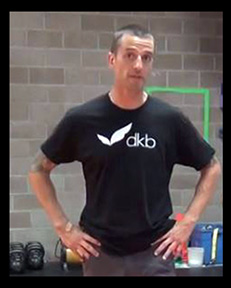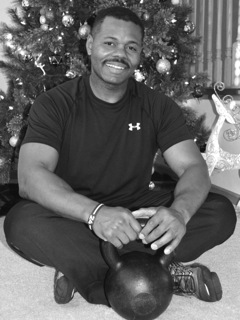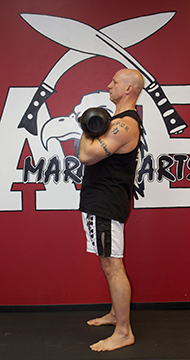 In this fourth and final installment dedicated to better utilization of the hips, I show some crawling progressions to emphasize that we can sometimes skip mobility drills and just move instead. But before we jump into part four, let’s briefly review the previous three pieces. First, we looked at some basic stretches done in a variety of positions to loosen up tight areas around the hips. In part two, we covered a very basic dynamic hip and hamstring mobility sequence to prepare field/court athletes or fighters for their active flexibility needs in competition. In the third piece, I differentiated “linkage” from “leakage” using the Hanging Leg Raise Sequence, and I went on to show how plyometric-style HLR’s can help with patterning powerful hip flexion/extension for the sprints.
In this fourth and final installment dedicated to better utilization of the hips, I show some crawling progressions to emphasize that we can sometimes skip mobility drills and just move instead. But before we jump into part four, let’s briefly review the previous three pieces. First, we looked at some basic stretches done in a variety of positions to loosen up tight areas around the hips. In part two, we covered a very basic dynamic hip and hamstring mobility sequence to prepare field/court athletes or fighters for their active flexibility needs in competition. In the third piece, I differentiated “linkage” from “leakage” using the Hanging Leg Raise Sequence, and I went on to show how plyometric-style HLR’s can help with patterning powerful hip flexion/extension for the sprints.
I reviewed the previous segments to set this piece up as continuing in the line of “linkage” discussed in part three. In the HLR sequence, we used linkage to generate explosive power and dynamic control. Today’s segment departs from the power focus and instead incorporates “linkage” to produce controlled efficiency of movement. My aim today is to demonstrate quiet rather than explosive movement.
While your average guy on the street isn’t yet acquainted with the notion of mobility, it’s been a trendy word in the fitness industry for several years. The few people who actually do mobility drills tend to stand in one place and make a series of circular motions through the joints from the neck down to the ankles. While this is an excellent thing to get fluid moving into the joints and surrounding tissues, it’s debatable whether these isolated drills actually produce better mobility. Today’s video, then, attempts to show how putting mobility in motion yields better results than isolating each joint while also being more fun.
There are six movements on the video. All of them both require and improve mobility in the hips. The first two are low crawls, one on the belly and one on the back. The next two moves are creeping squats, the first done from a traditional squat and the other from a Cossack squat position. The final two moves combine elements of the first four and add rolls. The goal on each of the six movements is to move quietly. If you can do them without producing thuds during the transitions, you aren’t leaking; instead, you’re moving efficiently.
In an attempt to elaborate on my notion of how linkage can create quiet as well as explosive movement, I’ll provide an exercise x-ray of the fifth move in the video: the creeping squat/roll combination. I set up the move in a Cossack squat position. From there, the flat foot shifts towards the ball of foot as the ankle extends to drop the knee to the floor. The knee drop carries my momentum forward. If I don’t rotate through my thoracic spine while flexing and rotating my neck, I’ll do a face plant. So, I opt for rotation. The previous movement clears the neck and spine so I can roll over the shoulder. An internal rotation of the rolling shoulder (imagine the Egyptian shoulder mobility drill that screws the shoulders into internal and external rotation) allows me to take the impact of the floor on the backside of the shoulder (thus avoiding jamming into the A/C joint). I roll across (not straight down) the spine to the opposite hip and back into the Cossack position. I do a creeping squat Cossack switch to get the other knee up and repeat the sequence to roll over the opposite shoulder. Basically, I have linked mobility drills sequentially from the feet up through the neck to produce movement.
In the RKC School of Strength, we emphasize the Turkish Get Up because it demands multi-planar movement through multiple joints while navigating the stability challenge of maintaining weight overhead. It is one of those few, coveted “desert island” exercises because of its strength, mobility and stability demands. If we hope to achieve the same great benefits from bodyweight exercises, we need to remember the mantra of “multiple planes, multiple directions and multiple joints.” While focusing on the hips is a great place to start in this endeavor, we must remember that dynamic movement is produced by systemic integration. Hopefully, the video that accompanies this piece can give you some ideas in making your movement more effective, integrated and enjoyable.
***
Mark Bixby is a Dragon Door RKC Team Leader, PCC Instructor and MovNat Instructor. He discovered kettlebells in 2002 and found that they are the quickest, most effective way to train. A combination of past injuries and persistent low physical self-image had caused Mark to have severe posture issues and chronic back pain. Kettlebells taught Mark how to use his hips so that he didn’t tuck his pelvis and slump with his posture. He grew taller, stronger and more confident. More than six years later, Mark has accomplished huge gains in strength, flexibility and stability and he finds that kettlebells still present significant physical and technical challenges. Because the skill set can always be refined, kettlebells continue to push Mark towards higher levels of body awareness and fitness. Mark can be reached through: http://www.dkbfitness.com/.

